Matrix & Sprite Libraries
http://www.arduino.cc/playground/Main/MAX72XXHardware
http://www.pjrc.com/teensy/td_libs_Matrix.html
***** Thank you 
Matrix & Sprite Libraries
The Matrix library allows you to control a large number of LEDs, with easy-to-use (but expensive) MAX7219 chips. Sprite is used with Matrix, to draw shapes. Download: Matrix & Sprite are included with ArduinoHardware Requirements
Matrix uses one or more MAX7219 chips, with a grid of LEDs connected.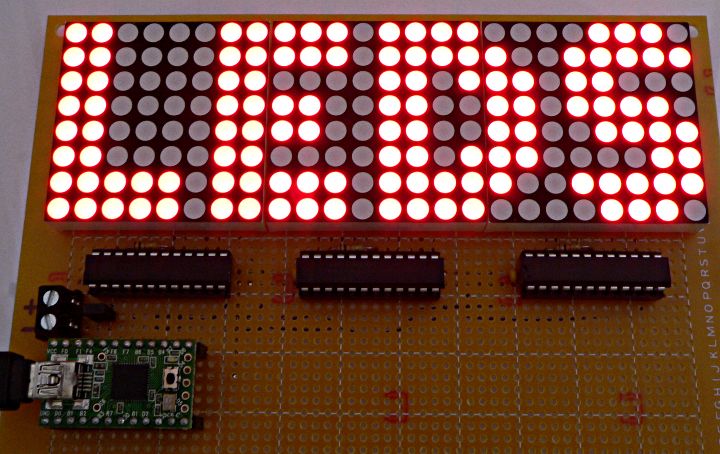
Basic Usage, Pixels Only
Matrix myLeds = Matrix(DIN, CLK, LOAD, numChips);
Create an instance of the Matrix object, using a name of your choice. DIN, CLK and LOAD are
the pin numbers where those signals are connected. You could create multiple object if you
have connected multiple, separately wired MAX7219 chips.
myLeds.clear();
Clear the entire display.
myLeds.setBrightness(15);
Set the display brightness, from 0 to 15 (brightest).
myLeds.write(x, y, value);
Change a single pixel. Value should be LOW for off, or HIGH for on.
Basic Usage, with Sprite
Sprite myIcon = Sprite(width, height, B11000, B11000, B11111, B11111);
Create a sprite object. You may create as many sprites as you need,
each with a unique name. The width should match the number of bits
in each data value, and the height should match the number of data
values.
myLeds.write(x, y, myIcon);
Draw a sprite to the display.
Example Pixel-Based Program
This program turns on a single LED at a time, rapidly scanning line by line, left to right and top to bottom. If you have just completed wiring your LEDs, this simple test can help diagnose any problems.#include <Sprite.h> // Sprite before Matrix #include <Matrix.h> const int numChips = 3; // DIN, CLK, LOAD, #chips Matrix myLeds = Matrix(16, 17, 18, numChips); void setup() { myLeds.clear(); } void loop() { byte x, y; // light one LED at a time, scanning left to right // and top to bottom... useful for testing the matrix for (y=0; y<8; y++) { for (x=0; x<(numChips * 8); x++) { myLeds.write(x, y, HIGH); delay(50); myLeds.write(x, y, LOW); } } }
Example Sprite-Based Program
This example prints "LEDS" in large letters, as shown in the photo above.#include <Sprite.h> // Sprite before Matrix #include <Matrix.h> // DIN, CLK, LOAD, #chips Matrix myLeds = Matrix(16, 17, 18, 3); Sprite letter_L = Sprite(5, 8, B11000, B11000, B11000, B11000, B11000, B11000, B11111, B11111 ); Sprite letter_E = Sprite(5, 8, B11111, B11111, B11000, B11110, B11110, B11000, B11111, B11111 ); Sprite letter_D = Sprite(6, 8, B111100, B111110, B110111, B110011, B110011, B110111, B111110, B111100 ); Sprite letter_S = Sprite(5, 8, B01110, B11111, B11000, B11110, B01111, B00011, B11111, B01110 ); void setup() { myLeds.clear(); myLeds.setBrightness(4); myLeds.write(0, 0, letter_L); myLeds.write(6, 0, letter_E); myLeds.write(12, 0, letter_D); myLeds.write(19, 0, letter_S); } void loop() { }
MAX7219 Connections for Matrix
Matrix requires non-obvious connections to the MAX7219 chip. The chip's datasheet won't help much, because it uses 7-segment display names. Here is a MAX7219 pin diagram with the Matrix-specific signal names: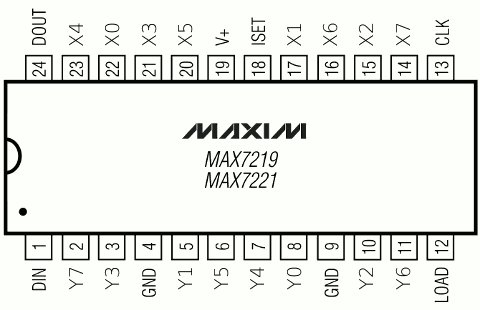
The 64 LEDs are connected in a simple matrix arrangement.
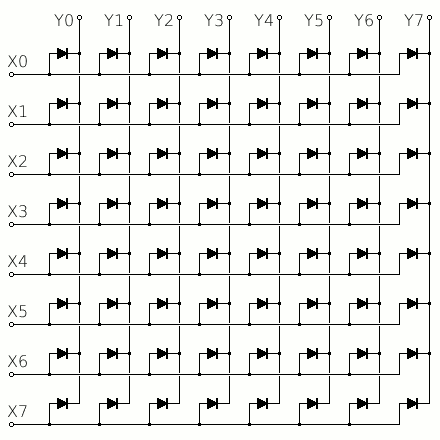
Using Multiple MAX7219 Chips
Each MAX7219 chip controls 64 LEDs. You can chain multiple chips to form a wide matrix, but the height supported by the Matrix library is always only 8. The CLK and LOAD signals are connected to all chips. Only one chip receives data from the Teensy on its DIN pin. It's DOUT pin chains to the next chip's DIN pin, and so on.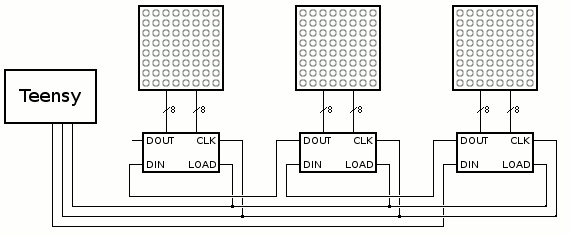
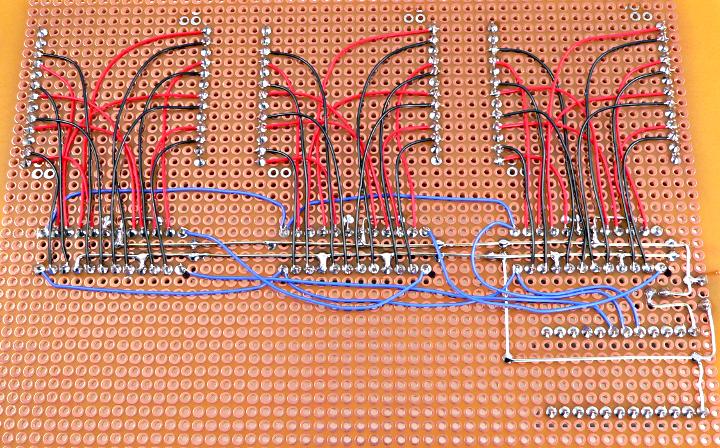
Power Consumption
With a 10K resistor on the ISET pin, each column of 8 LEDs can use approximately 50 mA with all 8 LEDs on, and the intensity set to maximum. With a small 8x8 matrix, 400 mA can be used. USB can provide 500 mA from a PC or powered hub, but only 100 mA from an unpowered hub.For a large matrix, external power will probably be needed. For example, the 24x8 matrix above can consume 1.2 amps when all LEDs are on at maximum intensity!
More Details
Please refer to the official documentation for more details.- Matrix Library Documentation
- Sprite Library Documentation
- Arduino wiki: MAX7219 and MAX7221 Led drivers